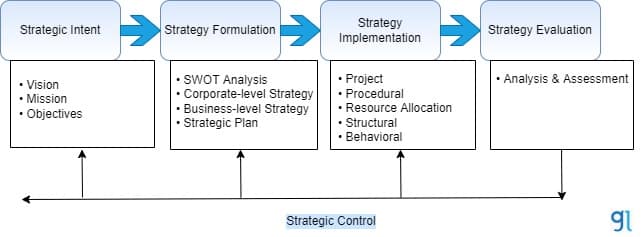In the absence of long-term goals and strategies, an organization will find it difficult to establish its path, organize its resources, and have a competitive edge. However, by using strategic management, organisations can survive as well as flourish. In this blog, we will talk about what strategic management is, how it is important, and how it helps enhance performance. Let’s get started, shall we?
You can also start with a free Strategic Management course to further your knowledge about the field and build a career in it.
Table of Contents
- What is Strategic Management?
- Importance of Strategic Management
- Implementing Strategic Management
- Conclusion
What is Strategic Management?
Strategic management is mostly about identifying and describing the strategies that the management may use to enhance efficiency and provide the company with a competitive advantage. If a company’s profitability is higher than its competitor’s, then that company is considered to have a competitive edge.
A manager’s decisions and actions that determine the performance of the company can also be grouped together as strategic management. For the manager to make the best decisions, the general and competitive organizational environment must be thoroughly understood and analyzed.
Key Takeaways
• Strategic management is a tool that can be used by businesses, colleges, nonprofits, and other organisations to set goals and accomplish them.
• Organizations that are versatile may find it simpler to modify their organizational structure and plans, whereas companies that are rigid may struggle in a changing environment.
• A strategic manager can develop strategies for firms to achieve their overall objectives and supervise strategic management strategies.
Importance of Strategic Management
Strategic management’s two primary components, to formulate and implement strategies, might be anticipated to have a number of advantages.
- Because the environment for most firms is changing so quickly, strategic management is the only approach to foresee potential issues and opportunities. It enables an organization to form opinions on long-term projections rather than on-the-spot judgments.
- Strategic management offers financial advantages. Based on empirical research and logical reasoning, it is possible to assert that the influence of strategic management is mainly that better financial performance in terms of growth and profitability of businesses with an advanced strategic management system having a significant influence on the formulation and management of strategies.
- People work effectively once they are aware of what is expected of them and where the company is headed. Strategic management gives all the employees specific goals and objectives for the company’s future. Additionally, this lessens conflict. It offers management and staff a strong motive to accomplish the company’s goal. Additionally, it makes sure that the senior executives agree on key strategic decisions and challenges.
- Group involvement in strategic management enhances the quality of strategic decisions. Owing to the unique viewpoints of group members, the practice of group discussion for decision-making allows the invention of alternative methods and better monitoring of opinion. Therefore, it is likely that the finest options will be picked and used.
- Enhanced employee motivation is a result of strategic management since it helps employees and managers better grasp the objectives and understand how the incentive system works. Additionally, they are more aware of the strategic plan’s built-in productivity-reward correlation. As a result, rewards are likely to be followed by goal-directed behavior.
- Strategic management reduces resistance to change. Greater knowledge of the factors influencing a decision and the limitations of potential alternatives are probable to occur from a participatory strategy-making procedure, which also has the added bonus of making changes more acceptable with less resistance. Resistance to change is made harmless by the procedure, which further eliminates the ambiguity that is linked to change.
Also Read: 14 Principles of Management
Implementing Strategic Management
Implementation of strategic management is divided into 4 steps. Let’s go ahead and have a look at these steps one by one.

Strategic Intent
It is the first step toward successfully implementing strategic management. It entails setting the organizational goals and utilizing them as a yardstick to gauge performance and advancement. Instead of being general, an organization’s goal and strategy should be clear, attainable, and measurable. Here, businesses describe their future strategic initiatives, which may include market dominance, shareholder wealth, or profits.
Strategy Formulation
This step calls for a SWOT analysis of the organization to assess its condition. This is where businesses conduct a forensic analysis of themselves, focusing on both the internal and external environments in which they function. This strategic analysis highlights the firm’s strengths, weaknesses, opportunities, and threats. A company can learn through this approach how it’s better than its competitors, where they are lagging, and what benefits its competitors have. They can then use this to design strategies for outperforming competitors and adapting to shifting market trends. Companies understand their present state and focus on where they want to be at this point as well.
Strategy Implementation
Organizational blueprints are a wonderful place to start for strategic management, but they must be put into practice. Plans should be put into effect to guarantee a company’s longevity, development, and expansion. Over 60% of the strategies are thought to be unsuccessfully applied. To successfully implement the strategy, you require
- Creating systems and structures
- Resource allocation
- Managing change
- Building decision-making techniques
- Competitive edge & more
Strategy Evaluation
Analysis and evaluation of the outcomes of the strategic process is the last stage of strategic management. Companies can choose whether to continue on the current path or alter their path to take the appropriate corrective action to adjust to shifting market trends by tracking the effectiveness of their organizational strategies. Organizations have the chance to assess performance indicators and implement interventions as needed through this continuing process. The strategic plan’s assessment provides a glimpse of potential failures and determines if the overarching company strategy needs to change course. Companies should regularly assess their strategy to ascertain what’s performing and what’s not.
Conclusion
Because it involves making important decisions, resolving issues, and taking advantage of opportunities, strategic management necessitates persuasive leadership abilities. In addition to having strong analytical abilities, company officials need to be able to interact with stakeholders and inspire employees to adopt their proposed ideas. Developing strategic management abilities can help leaders add value to their organisations.
If you wish to get into management and build a career in the field, do check the Post Graduate Program in Management for Executives. The program offers five trending specializations– Marketing Management, Data Science and Analytics, Operations Management, Human Resources, and Finance.









